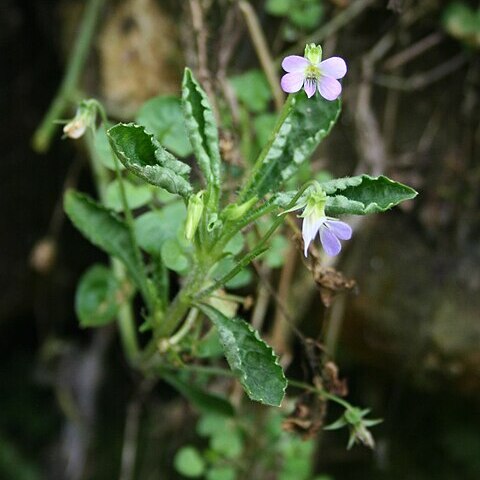Herbs annual, stiffly hairy or white puberulous throughout, or subglabrous, rarely glabrous, producing stolon at anthesis. Stolon with rosulate leaves at top, usually producing adventitious roots. Rhizome short, with numerous white rootlets and fibrous roots. Basal leaves numerous, fasciculate and rosulate, or alternate on stolon; stipules adnate to petioles at base, 2/3 free, linear-lanceolate, 4-12 mm, margin remotely denticulate or fimbriate-dentate, apex acuminate; petiole 2-4.5 cm, conspicuously winged, usually puberulous; leaf blade ovate or ovate-oblong, 1.5-3.5 × 1-2 cm, both surfaces densely white puberulous on young leaves, later gradually sparsely so, but still densely puberulous along veins and margin, or glabrous, base broadly cuneate or truncate, rarely shallowly cordate, conspicuously decurrent to petiole, margin obtusely dentate and ciliate, apex obtuse or ± acute. Flowers purplish or yellowish, small, long pedicellate, in basal leaf axils and leaf axils of stolon; pedicels 1.5-8.5 cm, slender, glabrous or sparsely puberulous, 2-bracteolate at middle; bracteoles linear. Sepals lanceolate, 4-5.5 mm, apex acute, basal auricles short, margin sparsely ciliate, apex rounded or remotely denticulate. Lateral petals obovate or oblong-obovate, 6-8 mm, glabrous or shortly bearded, anterior one ca. 6 mm (spur included), conspicuously shorter than other petals, apex acute; spur very short, only ca. 1.5 mm, slightly exserted out of basal auricles of sepals; spur of 2 anterior stamens triangular, short, broad. Ovary glabrous; styles clavate, slightly geniculate, gradually thickened in upper part; stigmas thickly margined on lateral sides and abaxially, slightly raised in central part, shortly beaked in front. Capsule oblong, 6-7 mm, ca. 3 mm in diam., glabrous, often with persistent styles. Seeds ca. 1 mm. Fl. Mar-May, fr. May-Oct. 2n = 26*, 74*.
More
Perennial or annual; rhizome vertical, rather thin, fibrillose, bearing rosette of leaves and flowers and procumbent rooting stems. Stems up to 12 cm, rooting at ends and producing dense rosettes of leaves and flowers. Leaves ½-3½ by 1-2 cm, smaller on stolons, suborbicular to ovate or elliptic, cordate to cuneate at base, subacute to obtuse or rounded, crenate to serrate-crenate on margin, long-decurrent on petiole; hirsute or rarely glabrous; petiole 1-7 cm. Stipules 5-9 by c. 1 mm, lanceolate or ovate-lanceolate, long-acute, dentate to fimbriate, green or pale brown, free. Flowers up to 9 mm, pale violet to almost white; peduncle 1½-6 cm. Sepals 3-6 by 1-1.5 mm, lanceolate to ovate, acute, sparsely hairy, fimbrio-ciliate, green; appendage c. 0.5 mm, rounded, sparsely fimbrio-ciliate. Petals 10.5-2 times as long as broad, obovate, the basal smaller than the others, the laterals not bearded; spur 0.4 to c. 1 mm, obtuse. Style c. 1½ mm, slightly geniculate at base, clavate distally, apex with 2 lateral lobes, with small anterior beak between lobes. Capsule 4-6 mm, ellipsoid, glabrous.
A herb. It grows each year from seed. It has white hairs. It has stolons or runners with a ring of leaves at the end. The leaves are 2-4 cm long by 1-2 cm wide. The flowers are yellow or purple.
Wasted slopes, stream edges, sparse forests and roadsides where they are damp and shady. Mountain forests, forest margins, grassy slopes, stream valleys, rock crevices; at elevations below 2,000 metres.
More
Wasted slopes, stream edges, sparse forests and roadsides where they are damp and shady. Mountain forests, forest margins, grassy slopes, stream valleys, rock crevices; at elevations below 2,000 metres.
Open places in montane forest and grassy clearings, often along tracks and other disturbed places, a weed of cultivation, 1400-2500 m. Fl. Aug.-March, probably later.
It is a tropical plant. It grows on the edges of mountain forests and by streams in valleys below 2,000 m above sea level. In Sichuan and Yunnan.
Can be grown by divisions or seedlings. Seeds needs stratification.

